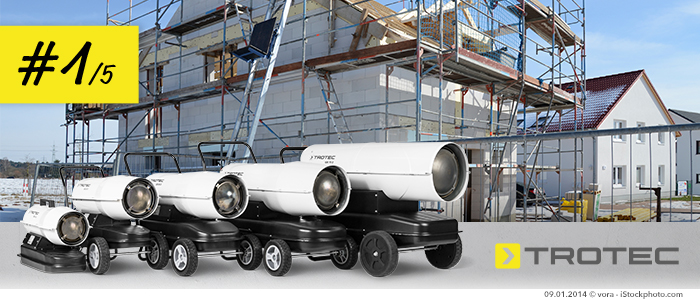How can I efficiently provide mobile heating to a building, hall or tent ? What is the difference between the direct and indirect oil heaters and what advantages do electric heaters offer me? And how do I calculate the the heating output level that I actually need? You will find the right answers to these questions and more in our new five-part advisor series “Mobile Winter Heating” – today we’re dealing with the topic of “direct oil heaters”…
For every intended purpose there is the ideal heater
In winter, there is a strong demand for mobile heating devices in many areas of the construction, industry agriculture and service sectors. And depending on the intended purpose, very specific requirements for the devices arise. This is because it makes a big difference whether you merely want to heat a building during its construction phase or also want to dry it quickly too. Perhaps it is a matter of heating well-ventilated winter building sites or of getting the right temperature in provisional accommodation such as tents.
One thing is clear: as the market leader for mobile heating solutions, Trotec always has the most innovative answer on offer – either for purchase or for rental. But to decide which heaters are best suited to which use, we should first take a closer look at the three most commonly used types: direct and indirect oil heaters as well as electric heaters. Starting with the direct oil heater: how does the device work and for which intended purpose is it suitable?
How direct oil heaters work
Direct oil heaters are optimally suited to use in open-air spaces for heating outdoor building sites, agricultural areas or in well-ventilated indoor spaces because they provide the generated heat in its entirety. This is also why direct heaters have no flue. In this process, it is possible to speak of 100% output because the heating power has an efficiency level of 100%.
In a directly heated system, the fan which blows out the heated air also provides the combustion air. First of all fuel is atomised in the combustion chamber, ignited and burned. Then the hot gasses are mixed in an exact dosage with the main air flow of the fan.
Therefore, along with the heat, direct heaters also release combustion exhaust gasses directly into their surroundings. They are therefore not suitable for enclosed spaces without good ventilation if people or animals might spend time there. Because a large amount of humidity is also released during the combustion process, direct heaters should never be used for drying purposes.
Indirect oil heaters and electric heaters are suitable for drying or for heating spaces where people spend time. These devices will be looked at more closely in the upcoming parts of this advisor series.
Do you want more information about direct oil heaters?
Then look at out oil heater fans from the IDE or IDS series in greater detail – fantastic heating and fantastic prices all in one. With heating outputs of between 20kW and 100kW, these heaters hotshots offer solutions that are both economical and reliable for typical mobile heating operations on building sites, in halls and workshops as well as in agriculture. You can get more information online – in our Trotec shop!


